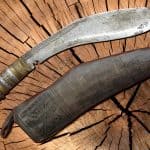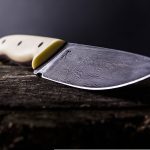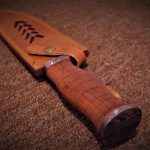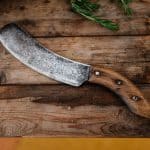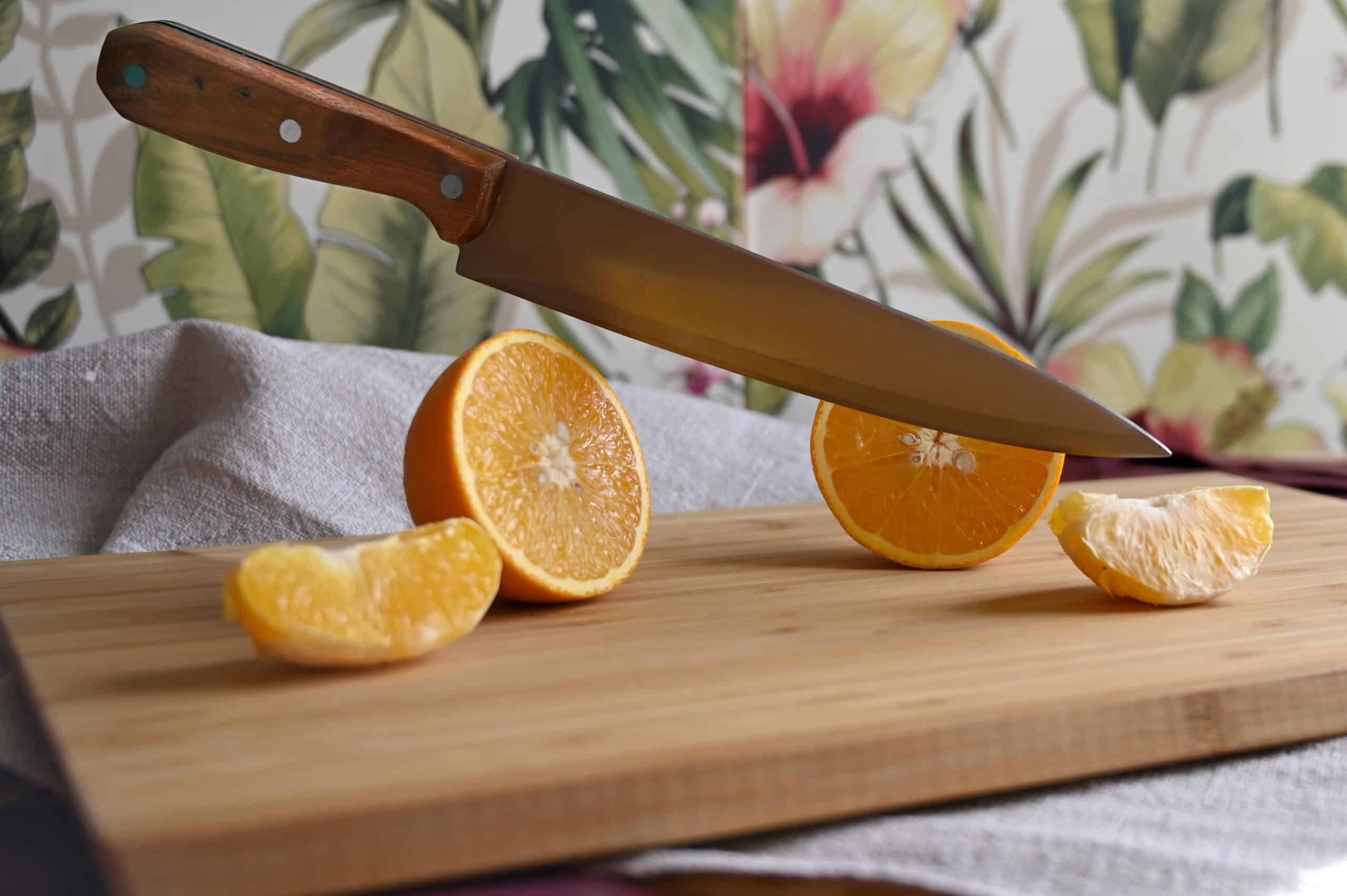
Introduction
Using a strop is a key part of the knife sharpening process and one that shouldn’t be overlooked. A strop is a type of sharpening block commonly used to hone knives after they have been ground on a stone or steel. Not only can stropping help bring out the shine in your blade, it will also help keep your knife sharp for longer periods of time.
Step 1: Preparing the Strop
Before you use the strop on your knife, make sure you condition it first. You may want to use beeswax, leather dressing, or sanding paste for easier stropping – it just depends on the materials that your strop is made of. If you don’t know what type of material your strop is made from, read up on proper steps for conditioning different types of strops.
Step 2: Honing with the Strop
Once your strop has been properly conditioned, carefully draw your blade across it away from you at an angle of approximately 20 degrees. Don’t press too hard as this could damage your knife but press firmly enough so you can feel some resistance on the blade as it slides over the surface. Make sure to go over each side of the blade multiple times in both directions (i.e., push and pull strokes). The standard number of strokes per side should be about 10-15 to ensure that all burrs are removed off the blade edge along with small scratches and imperfections created by previous honing with other stones and devices such as diamond hones or ceramic rods.
Step 3: Test Your Knife Edge
Once you have finished stropping each side of your knife, test its edge by slicing through paper or fabric. If done correctly, you should notice a smooth yet distinct cutting action taking place when performing this test which suggests that sharpness has been achieved! Congratulations!
Different Types of Strops Available
When it comes to sharpening knives, strops are hugely popular. Strops are a simple way to hone and polish a blade, allowing it to retain its sharpness for much longer. There are many different types of strops available ranging from leather, webbing, canvas and more.
Leather strops can generally be the most expensive option but are capable of delivering the best results. The leather is secured on a block of wood or other base material (often made with magnets) making it easier to maneuver when sharpening the knife. When you use a leather strop it is important that you knows which direction the fibers in the leather run so that you can properly sharpen your knife against them.
Webbing strops or cloth strops work in much the same way as their leather counterparts but they often contain abrasive substances such as chromium oxide powder or diamond paste which acts as an extra buffer against the blade causing the steel to become ultra-smooth and shiny.
Canvas strops have no abrasive materials included and therefore cannot provide any honing action but they do help prevent burrs forming on a blade while also helping keep it clean and rust-free in between uses. While not as effective as using other types of strop, if used regularly they can help maintain your blades sharpness over time.
In short, no matter what type of strop you decide to use learning how to use it properly is key for ensuring that your blades remain razor sharp throughout their lifetime. Before starting make sure to read up on any additional instructions concerning your specific device and always remember safety first when handling anysharp objects!
The Benefits of Using a Strop to Sharpen Knives
Using a strop to sharpen knives can offer many advantages over other methods of sharpening. A strop for honing knives is inexpensive and simple, often lasting almost forever if cared for properly. It’s much smaller than wet stones and provides a fast-acting means of maintaining an edge. To use a strop, one must first prepare it by coating the surface with some sort of lubricant or abrasive material such as Stropping Compound or Barbers Rouge. This will help to remove any burrs that may have built up along the blade since its last sharpening before polishing the edge to a razor-like finish. Once you’ve prepared the strop, simply draw the knife across the leather in even strokes, applying light pressure at each stroke so as not to damage the blade. The number of draws required depends on how dulled or damaged your blade is but aim for between 4-6 strokes per side, repeating this until desired sharpness is achieved on either side. Be sure to keep your strop lubricated throughout this process as well as frequently check your progress using various test materials such as paper or cardstock. This will ensure consistent results between each session and help you keep track of just how sharp you want your blades!
How to Choose the Right Strop for Your Needs
When selecting a strop for sharpening your knives, it is important to consider the material that the strop is made from, as this will greatly influence its effectiveness. Generally speaking, leather strops are most popular since they naturally have some “give” in them which improves their performance; however, canvas, linen and even wood strops can all be used effectively as well.
It is also important to choose a strop that fits your exact needs. If you need to sharpen large knives or pairs of scissors, look for a larger strop with plenty of room for the blade. Also be sure to find one with an appropriate texture; some strops feature smooth or heavily textured surfaces which can affect how effectively they remove burrs and grind away imperfections. Lastly, consider how long it should last: as leather strops are more expensive than synthetic materials but can provide more superior results with more frequent use over time.
Once you have chosen the right strop for sharpening knives, it’s time to get started. First, you will need to lubricate the surface of the blade in order to get an even edge when applying pressure during sharpening. This can be done with a light-weight oil like mineral oil or vegetable shortening before beginning on your strop. Place the blade onto one side of the strop at a 20 degree angle and draw it back toward you in one continuous stroke about five times until burrs emerge. Then switch over to the other side of the strop and repeat this process without lifting the blade off the surface. As soon as you feel that your knife is sufficiently sharpened, wipe off any excess grit and oil with a mild soap before dry-towel honing your blade on a separate piece of cloth until its edge is razor-sharp!
How to Prepare the Strop for Sharpening
Before you begin sharpening a knife with your strop, it’s important to prepare it properly. Begin by tightening any screws or clamps that may be present on the strop. Next, you’ll want to establish the correct medium for sharpening, which can range from leather to canvas. To prepare the strop medium, use a surface conditioning product specifically designed for that type of material. For leather strops, you should use a leather balm or conditioner; and for canvas strops, a fabric stiffener is ideal. Once conditioned, attach the strop safely and securely to your workbench or other flat and stable surface using clamps or screws. If the strop has any leather sides attached ensure that all of them are in an upward-facing position when you attach it to your workspace.
Positioning the Knife
Now you’re ready begin sharpening! To start off your first few passes, hold your knife so that its edge sits parallel with one side of the strop (Whichever side is most comfortable for you). Slowly draw the blade across the stroke two and four times, depending on how dull it is. After several passes from one side of the strop, switch over and repeat using strokes in opposite directions along the other side. Each pass should feel smooth yet slightly slightly resistant as you pull outwards away from yourself along each stroke trajectory in order to maximize comfort and safety while still getting good results at removing metal particles from blunted edges. Aim to achieve between 10-20 passes per side per knife edge before inspecting its progress visually.
Re-Positioning and Re-Sharpening
Once you’ve completed your passes and have verified visually that they were successful in removing metal particles from blunted edges and giving life back to an otherwise dull knife blade, gently reposition both your knife hand holding position as well as where on either blade side which makes contact with your strop until future sharpenings become more predictable – ensuring uniformly dulled blades become sharper every time no matter where on either blade their point of contact starts! Specifically move down about 1⁄4 inch (.635 cm) after after each set of 10–20 passes through both sides, then continue repeating step until desired sharpness has been achieved – or until only needing minimal sharpening every week or two according to personal preference!
How to Sharpen a Knife With a Strop
A strop is a leather strip designed for sharpening knives and other sharp edges. Strops are typically used in combination with honing compounds, like diamond dust, to sharpen the knife quickly. While stropping may seem complicated, it’s actually a simple process once you’ve figured out how it works.
Before you begin, be sure that your strop is clean and free of any previous compounds or oils. Also check to make sure your strop has been conditioned with a light coating of some sort of lanolin-based oil or wax – this will help to prevent any damage to the leather as you work.
Next, choose an appropriate honing compound and lightly apply it to the rough side of the strop. It’s important to apply just enough compound so that it covers the entire surface without clumping in any one area. Once you have applied the honing compound, take your knife and lightly draw it across the length of the strop from back to front. Be sure not to apply too much pressure as you do this otherwise you might end up dulling your knife instead of sharpening it. Make about 8-10 passes on each side of the blade before flipping it over and repeating on the other side.
When finished stropping your knife, make sure to brush off any excess honing compound with a dry towel before wiping it down with a clean cloth that has been dampened with mineral oil or some other non-abrasive liquid. This will help maintain its edge longer while also helping keep your strop clean and well-maintained for next time use.
Different Sharpening Techniques for Different Knives
When using a strop to sharpen knives, it is important to use the appropriate technique for the type of knife you are sharpening.
For straight-edged and utility knives, the best way to sharpen is by alternating between pushing and pulling strokes. Begin with a pushing motion in which you draw the blade towards you following along the strop in a smooth motion. As you reach the end of the strop, turn your wrist so that you can pull away from yourself in a curving motion. This will give your blade an even and consistent level of sharpening.
Serrated edges are slightly more difficult to sharpen on a strop than traditional blades. Serrated knives require that longer strokes be used while moving over the surface at all angles. Start by placing your knife perpendicular against the surface and pull it forwards through multiple times with enough pressure so that each tooth can pass cleanly over the strop without catching during any part of its movement.
For single-beveled Japanese-style knives, hold them at an angle between 15 to 25 degrees as you quickly move them back and forth across your stropping material in swift motions aiming for uniformity. It is likely that multiple passes may be needed for effective sharpening; however, strive not to go too hard as this could damage your blade or create an uneven finish on it’s edge.
Troubleshooting Common Strop Issues
If your knife’s edge isn’t sharpening adequately with the strop, there are a few different common issues that could be to blame.
1. Angle: Make sure you’re positioning the knife at the right angle when it comes into contact with the strop. Ask an experienced knife sharpener what angle they would suggest for the type of blade and hardness that you’re dealing with in order to get best results.
2. Pressure: Too light a pressure won’t do much of anything– similarly, if you press down hard enough, it will actually dull the blade further. Experiment to find a medium that passes over the strop nicely without digging down too aggressively into it.
3. Stropping medium: Are you using oil or moveable compound? You typically want something for polishing or honing so make sure this is fresh and appropriate for your needs and updated often!
4. Strops: What material is your strop made from? This can range from leather, hardwood, or synthetic materials. Sometimes it takes minutes and other times hours depending on how coarse your edge was entering stropping – but if it still hasn’t been successful after multiple attempts consider switching out materials or making adjustments as mentioned above!
Conclusion
Using a strop to sharpen knives is one of the best and easiest ways to keep your kitchen tools sharp. This method gives you all the control and accuracy that you need, while also giving you versatility in terms of the materials you use. You can use leather or canvas strops along with a range of different compounds like compound powder, chromium oxide, and diamond abrasives. You can also put custom pressure on the blade as needed to get a perfect edge every time. All in all, using a strop is an easy, effective, and safe way to keep your knives sharp and ready for any application.








